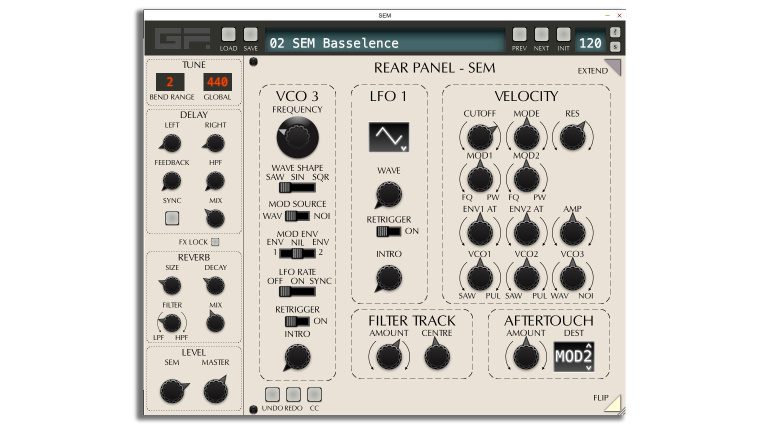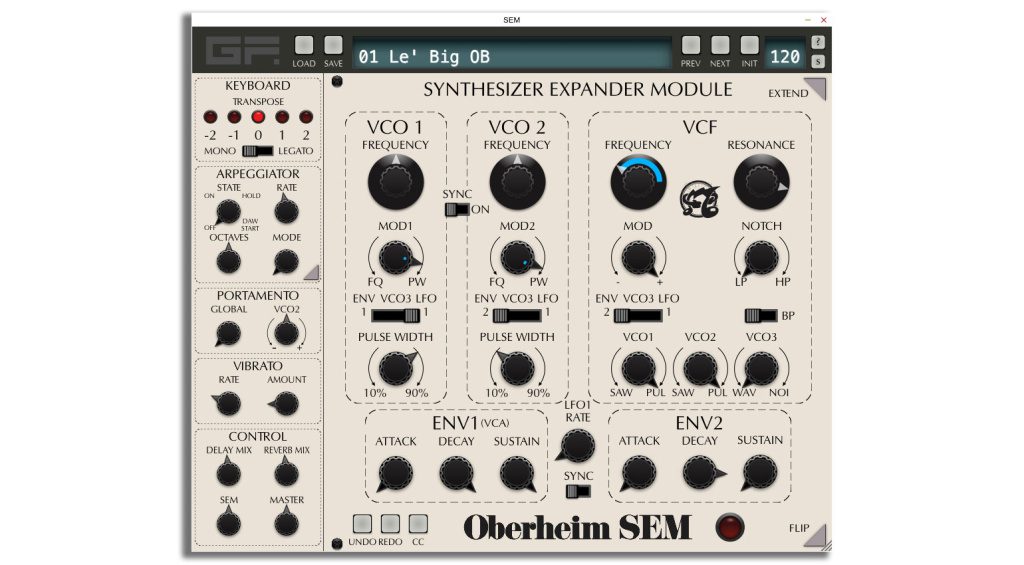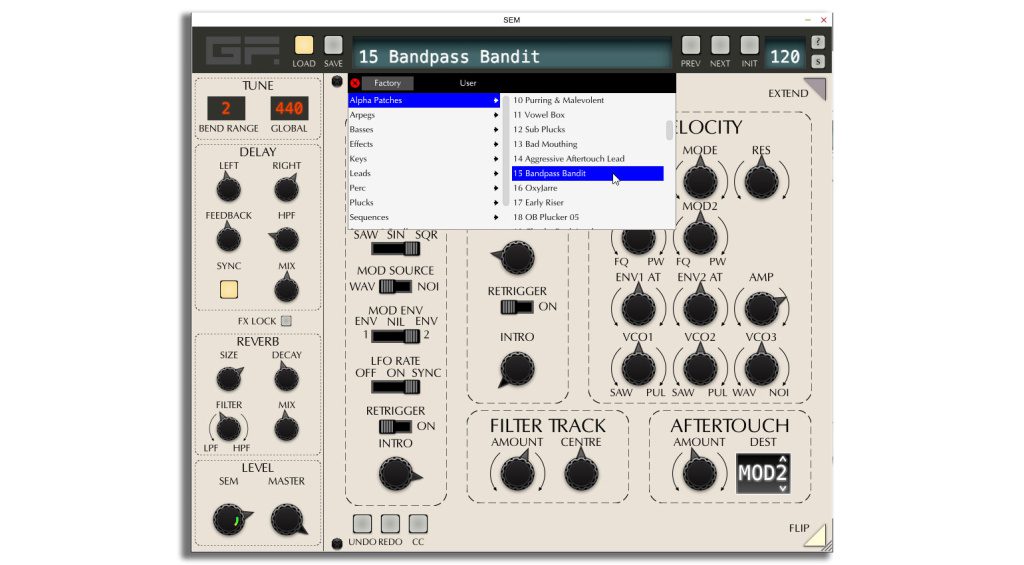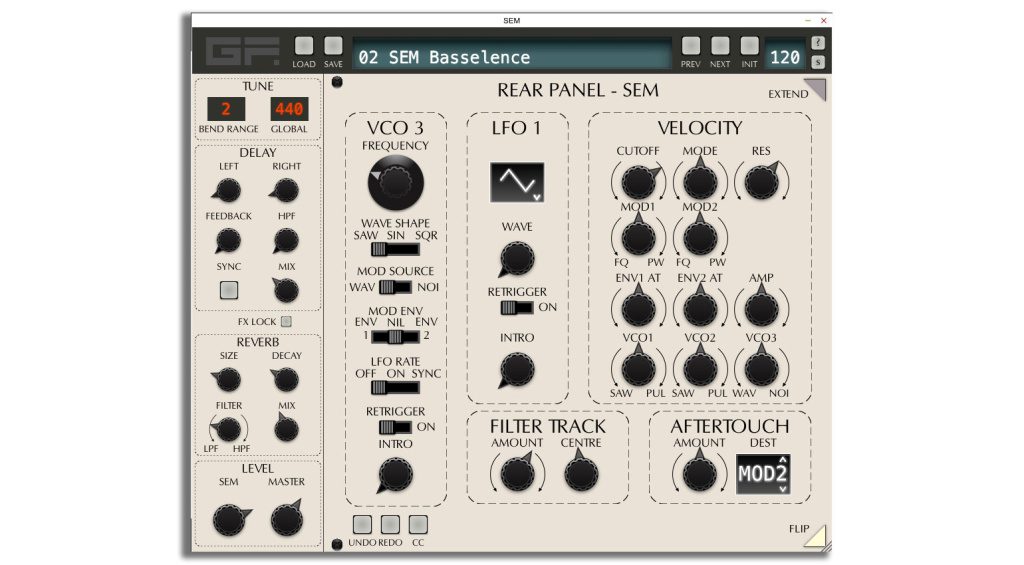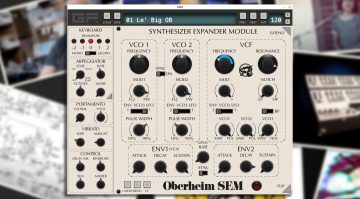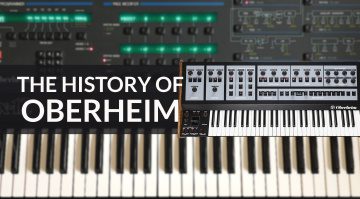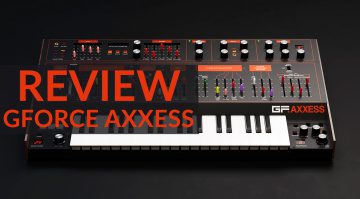Review: GForce Oberheim SEM, the perfect emulation?
Like a majestic slab of synthesiser history, the SEM rises above the noise of waveforms and floats on a sea of hard-earned nostalgia. Has Gforce Software captured the soul of this Empress of monosynths?
Synthesizer Expander Module
Earlier in the year, GForce Software released version two of their Oberheim 8-Voice emulation, the OB-E. It prompted Tom Oberheim to endorse a piece of software for the very first time. So when it came to pulling out a single SEM from the 8-voice machine only an idiot wouldn’t have invited Tom along for the journey. So they did. Tom’s response to this officially endorsed software SEM was to say “It’s so good to hear something that’s dear to my heart done properly in software.”
I don’t think we’re going to be in any doubt about whether the GForce Oberheim SEM sounds authentic. If you want my quickest summary then the best way to describe the sound is as “flipping awesome“. The opening preset alone is enough to sell the gorgeousness of this oh-so-familiar synth. So with that spoiler out of the way, let’s see what it’s all about.
You are currently viewing a placeholder content from YouTube. To access the actual content, click the button below. Please note that doing so will share data with third-party providers.
Getting into SEM
The SEM, as we should all know by now, is the Synthesizer Expander Module designed by Tom Oberheim in 1974 to accompany the Oberheim DS-2 sequencer. It was designed to complement other synthesizers like those from Moog and ARP and was fairly basic and easy to use. It had two oscillators, designed by E-mus’ Dave Rossum, that gave it a deliciously detunable quality.
The filter came from Dennis Colin, the designer of the 1047 Multimode Resonator found in the ARP 2500. There were a lot of 24dB filters about at the time and so Tom commissioned him to design a 12dB filter with lowpass, bandpass and highpass modes. The combination of those VCOs and that filter somehow created something beautiful that’s stayed fabulous ever since.
GForce SEM action
Emulating the SEM after the success of the 8-Voice OB-E seems like a no-brainer to me. In fact, it almost feels a bit backwards. The 8-Voice is a hugely complex machine whereas the SEM is simple and achievable, why not start there? GForce Software is nothing if not ambitious. But the advantage is that they can bring everything they’ve learned through two versions of the OB-E and combine it with Tom’s input to bring us a completely sublime emulation.
So what do you get? You get a full-on vintage monosynth. You have the two VCOs with sync, tuning and pulse width modulation. Each oscillator outputs a sawtooth and square waveform which you can mix between. The 12dB multimode filter lets you dial in from lowpass to highpass via a notch, and for bandpass, you flick a switch. There are two Attack, Decay, and Sustain envelopes, one dedicated to the VCA, the other one freely assignable. The lack of Release seems odd at first but the Decay knob actually doubles up on that function and so you don’t really miss it.
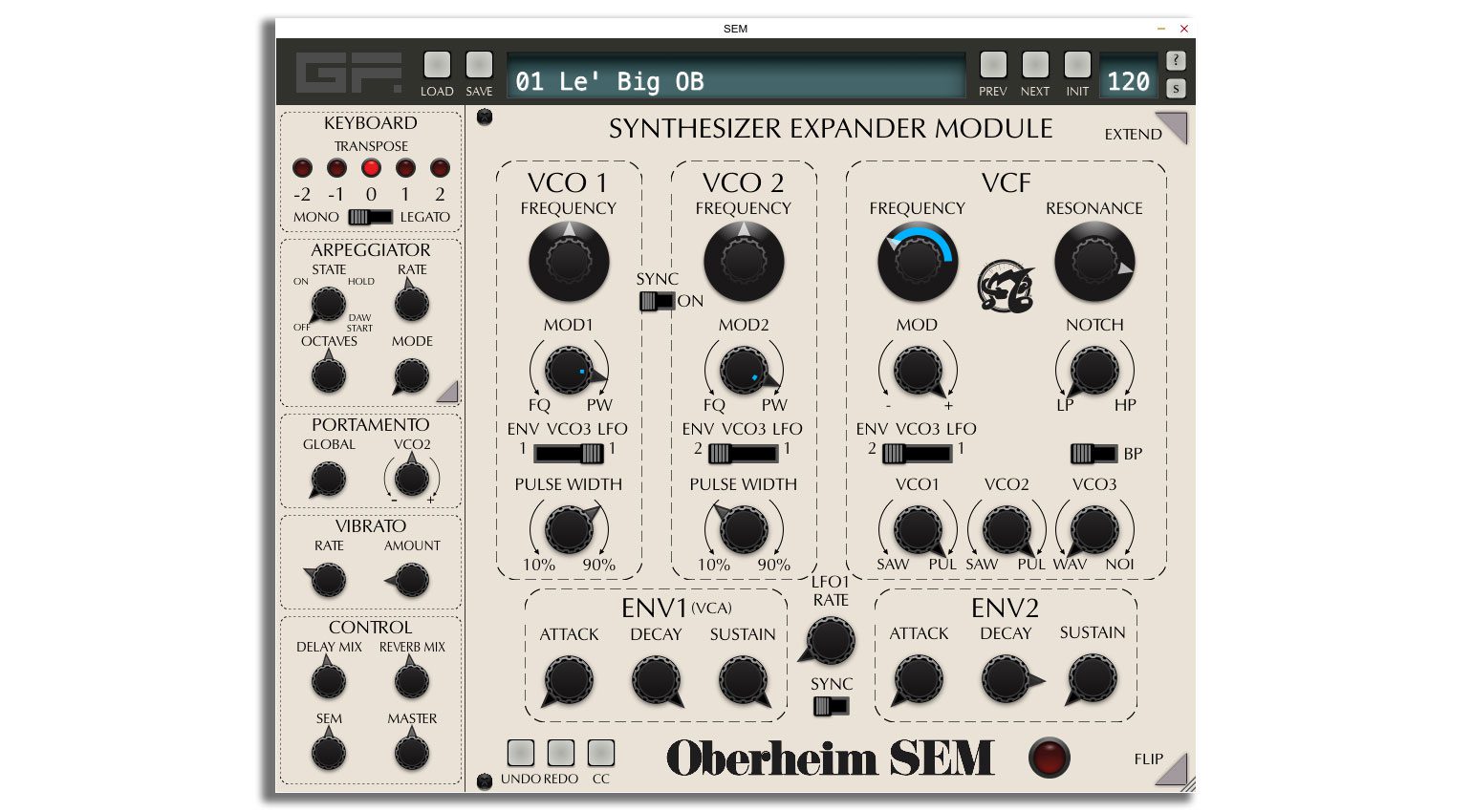
The last knob on the front of the authentically modelled front panel is the LFO rate. Originally a triangle LFO whereas now we have all sorts of waveforms to choose from. And that’s always a thing with software developers, they can never resist adding a few extras that they think the original was lacking. Or in this case, it’s more about adding in the things that Tom added to later versions like MIDI control, portamento, transposition and vibrato.
New additions
However, there are some new things that came with the OB-E and have made it across to the SEM. The obvious one is the third oscillator. The extra VCO can be used as a sound source which adds sine waves and noise to the roster of waveforms, or as a source of modulation. Velocity and Aftertouch can be used as modulation sources and you have a lot of control over what you can route them to. What GForce hasn’t done is duplicate the voice to make it polyphonic. This SEM emulation is resolutely monophonic.
GForce has added an arpeggiator and a simple sequencer which essentially creates steps for the arpeggiator. These are very welcome, as are the Delay and Reverb effects that bring in a thoroughly gorgeous dimension to the sound. They are exactly what you would plumb a SEM through. It doesn’t really get much more complicated than that which is, after all, the point.
That sound
The first preset is an absolute doozie – Le’ Big OB. It is everything an Oberheim should be and you get absolutely lost in the hugeness and wonder of that unmistakable sound. Through a little bit of filter Mod Level tweaking and Env2 manipulation, you can bring out era-defining synthesizer sounds. The first bank of “Alpha Patches” as they are called on my pre-release version is simply lovely. There are tones of purity, zaps of sonic lasers, slices of filtered blades, bouncing engines of growling intensity and all of it is so intuitively tweakable.
If I can step back for a moment and moan about something then I’d like to talk about the preset system. You have to click a Load button that brings up an ugly-looking menu of category banks with scrollable patches. While it functions well enough the menu doesn’t go away if you select a sound, you have to click away. It’s far smoother to use the Prev and Next buttons but that only takes you through one bank. I want to click on the preset name and have a good-looking library window appear that fades away once I’ve selected a sound. It’s a remarkably clunky thing in an otherwise beautiful interface.
One thing that is nicely accessible is the “Init” button to initialise a patch. This drops everything to its default basic setting and leaves you with a single sawtooth wave to start off. From there in a few moments, you can be enveloping the filter, adding a detuned second oscillator, boosting the resonance, nudging the wet/dry mix on the delay and reverb. Before you know it you’re off on a synth adventure.
Here’s a video of me incorporating the SEM into a Eurorack patch using that first preset. I’m sending the computer (Surface Pro 8) CV, gate and modulation from the modular via a Befaco ACDC USB module. Bitwig Studio is doing the CV-to-MIDI translation.
You are currently viewing a placeholder content from YouTube. To access the actual content, click the button below. Please note that doing so will share data with third-party providers.
The interface
I’ve never found the look of the SEM particularly inspiring. It always reminds me of a bit of ageing hospital equipment. But this is one of those occasions where I don’t really care about the styling because it sounds so good.
To accommodate the newer features GForce has given you a couple of ways to view it. By default, we have the regular front panel view of the two VCOs, filter, envelopes and LFO. To the left are some of the more recent additional controls like the arpeggiator, transpose options, vibrato, portamento and also control over the effect and master levels. All the other new stuff like the third VCO and modulation routings are all housed on the virtual back of the synth. A “Flip” button gives you access to the alternative panel.
Extendable
If you prefer you can hit the “Extend” button and you get front and back panels side by side with everything accessible all at once. The interface is dynamic and can be smoothly resized by dragging out the corner. I like how whatever knob you move gets its value displayed in the preset name window. If you double click something it will return to zero or its off state which is very handy. MIDI mapping is very easy via the “CC” button. Simply engage CC mode, click on the parameter you want to control and turn a knob on your controller – done.
Modulation assignment is nicely handled via colours splashed on the knobs showing you the range that the modulator is affecting. It gives you a good sense of what’s being modulated. Although it would be even more lovely if the knobs animated in response. It wouldn’t be very authentic but it is something that software is very good at and I’ve become accustomed to watching knobs move on software synths in response to modulation. It’s a shame that doesn’t happen here.
However, there are some bonus points to be claimed because the interface is completely touchable in multiple places. If you have a touch screen on your computer then you can touch and control as many knobs as you have fingers.
SEM Imperfections?
I find a few things that it doesn’t do mildly annoying. The first thing is that it doesn’t drone. You can’t seem to be able to open the VCA and just let those oscillators sound. It requires you at the very least to press a key on your keyboard.
And actually, the reliance on MIDI feels a little bit inauthentic. I’d really like the opportunity to trigger the arpeggiator or sequencer without having to play a keyboard. The original, as we know, was designed for the DS-2 sequencer, so couldn’t we have a sequencer that steps by itself? Well, actually, it can. While in sequencer mode if you click the big LED to the right of the words Oberheim SEM it will trigger the ARP. This starts playing the current sequence without any further input. However, you can only create the sequence in the first place with a MIDI keyboard so it’s not really a keyboard-free solution.
Thirdly, I think it would be nice if the arpeggiator could be decoupled from the preset. While it’s great to be able to save the arpeggiator settings as part of a patch it would also be great to be able to have the arpeggiator running while you audition sounds. Update: You can do this via the “ARP Lock” button – nice!
Those are minor things really.
Presets to die for
I’ve just found a preset called CS-esque 01 and it’s just wonderful. The velocity mapping through to the cutoff is excellent, gives it such an interesting attack. The slight wobble from the LFO and VCO3 into the pitch of the two main oscillators gives it a vintage feel and somewhere in there is some noise that fizzes with CS-80 vibes. And then that reverb – it’s really nice.
Conclusions
The GForce Oberheim SEM is an exemplary software synthesizer. It’s playable, musical and takes you on a voyage of synthesizer adventure with every preset. It’s uncomplicated, unfussy and almost impossible to make a bad sound on. SEM is a great synth for beginners but will also reward any synth enthusiast who wants to bathe in the Oberheim experience.
The Oberheim SEM by GForce Software is available now for MacOS and Windows for and introductory price of £29.99 ex VAT.

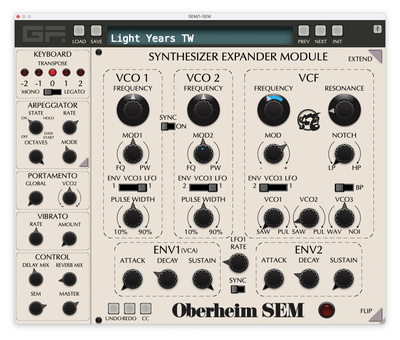
You are currently viewing a placeholder content from YouTube. To access the actual content, click the button below. Please note that doing so will share data with third-party providers.

 5,0 / 5,0 |
5,0 / 5,0 | 
